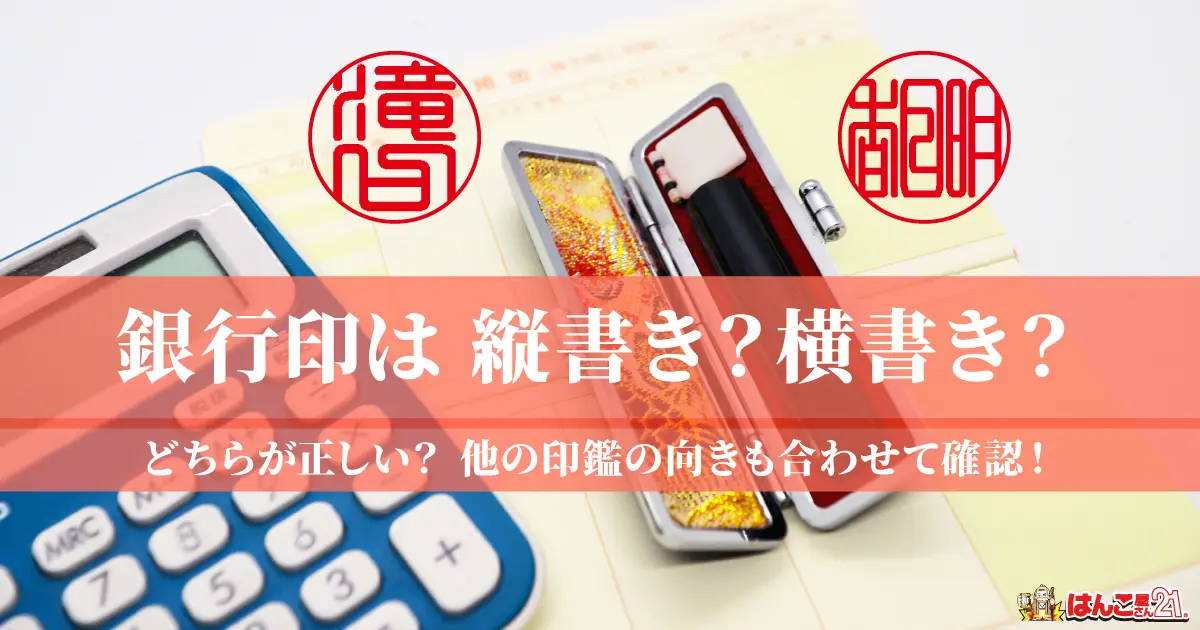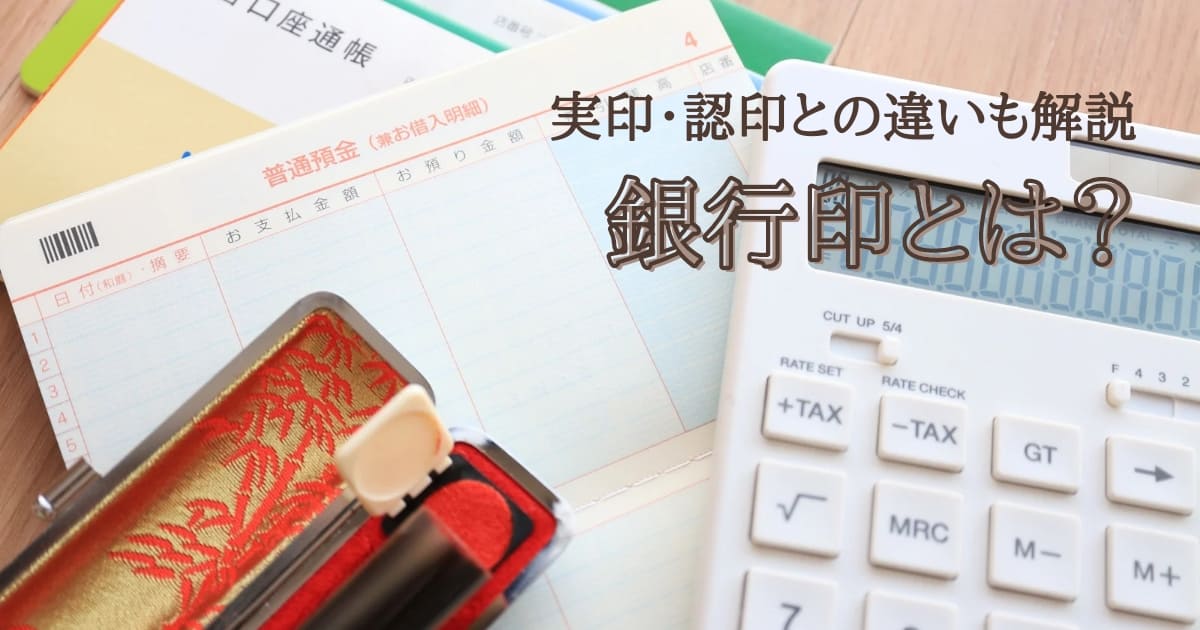HANKO are generally written vertically, but they may also be made horizontally depending on the purpose. Do you know which is correct for bank seals, vertical or horizontal writing?
There are also HANKO with your first name, first name, and full name, but which one is more appropriate?
For those who want to make a bank seal, or those who are unsure of the details and orientation of the stamp, we will explain the details and orientation of the bank stamp.
What is engraved on the bank seal?
First, let me explain the name to be engraved on the bank seal.
There are no particular rules regarding names when it comes to bank seals, so you can have one made with your last name, given name, or full name. There is no rule that it has to be your last name.
You can choose the one you like. Try to choose one that will stand out from the rest by matching it with the engraved contents of your other HANKO.
General markings for men
Most men use their surnames on their bank seals. In order to avoid getting confused about the HANKO, many people separate the registered seal from their full name and the bank seal from their last name, etc.
General markings for women
For women, there is a possibility that your surname will change when you get married, so many people create a HANKO using their first name. Since there is no regulation that a bank seal must be a surname, a HANKO with the name below can be used as a bank seal.
Many people create a new bank HANKO for their surname when they get married and change their surname, but there are also a certain number of people who continue to use their name HANKO as a bank seal.
What is the recommended content for the bank seal?
Should the name be engraved on the bank seal: the last name, first name, or full name?
For men, it is a good idea to choose one that is easily distinguishable from a registered seal. If the registered seal is your full name, please make sure it is easily distinguished from the registered seal by using your first name or first name.
For women, it is a good idea to create a new name in anticipation of changing your last name. Of course, if you make it easy to distinguish it from the registered seal, you will avoid making mistakes yourself. We have summarized the advantages and disadvantages of each, so please choose the one that suits you.
Advantages of last name
The advantage of using a surname is that it can be created in a smaller size than a full name, so it can be cheaper. It is also a safe choice since many people generally make HANKO with their surnames.
The size (diameter) of the bank seal is approximately 12 mm to 15 mm between the registered seal and the registered seal.
Disadvantages of last name
The disadvantages of creating a HANKO with your surname are that you may have to re-seal it if your surname changes due to marriage, etc., and there are a certain number of HANKO with the same HANKO compared to those with your full name.
At Hanko Shop 21 , a professional designer creates each stamp to differentiate it from other HANKO with the same surname. We especially recommend choosing typefaces with complex designs, such as seal typefaces and stamp typefaces.
Advantages of the name below
The advantage of creating a seal using the first name is that you do not need to create a HANKO even if your last name changes due to marriage, etc., so it is recommended for women.
Similar to a surname, it can be created in a smaller size than a full name, so it is cheaper.
Also, when creating and managing bank accounts for each family member, if everyone in the family uses the bank HANKO with their last name, it may be difficult to tell who is using which bank seal. If you use the names below, you can easily tell the difference at a glance, making it easier to understand when managing family members at once.
Disadvantages of the name below
The disadvantage of using a lower name is that the design becomes simpler than the full name, and the name may overlap with someone else's name.
Advantages of full name
The advantage of creating a bank seal with your full name is that it can be restricted to specific individuals. The design is complex because it is created using a seal typeface or a seal calligraphy, and it is the least likely to be forged compared to a HANKO with a surname or first name.
Disadvantages of full name
The disadvantages of a full name are that, like a surname, if your surname changes due to marriage, etc., you will need to reseal it, and because it is a full name, the size is larger at 15 mm to 18 mm, making it more expensive than a surname or lower name HANKO. . Also, if you create a registered seal with your full name, it will be difficult to tell the difference. If the registered seal is your full name, it would be better to use something else.
Is the bank seal written vertically? Horizontal writing?
Is it better to write a bank seal vertically or horizontally? Similar to the name to be engraved, there is no regulation as to which one to use, so it can be written either vertically or horizontally. Please choose the one you like. Generally, many people choose vertical writing.
What is the difference between horizontal writing and vertical writing?
Although many people choose to have their bank seals written vertically, bank seals were originally made with horizontal writing to make them easier to distinguish from personal seals.
Additionally, some people choose to write horizontally for reasons such as feng shui or good luck.
If written vertically, money will flow from top to bottom. Some people write horizontally to prevent money from flowing from top to bottom.
However, one thing to keep in mind when writing horizontally is that in the case of HANKO, horizontal writing is the old horizontal writing, which is read from right to left.
Currently, horizontal writing is read from left to right, which may feel a little strange to some people.
If you are "Sato", the form would be "Fujisa". There is no problem with Mr. Sato, but you need to be careful, for example, if the name can be read backwards and still be valid as a surname. "Tanaka" becomes "Nakata" from right to left. It can be difficult to know which direction to read from, so if you can read from the opposite direction, we recommend that you do not force yourself to write horizontally. Please consider readability and understandability.
Also, in the case of foreign names using katakana or especially alphabets, they are written from left to right to ensure the correct reading and meaning.
At Hanko Shop 21, when making horizontal HANKO, you can specify "right to left" or "left to right" when ordering.
Bank seals are sometimes made in horizontal writing to distinguish them from other HANKO.
Some people say that when they have a registered seal, a registered seal, or a bank seal, they can't tell them apart at first glance, or they can't tell them apart unless they press it.
Horizontal writing is also recommended for bank seals. In general, many HANKO are written vertically, and most people's registered seals are probably written vertically as well. Have you ever experienced things like "I can't tell the difference between a registered seal (registered seal)" or "I don't know which one is the registered seal"? Both the registered seal (registered seal) and the bank seal are written vertically, and if only the last name is written, it may be difficult to tell which is the registered seal. By writing bank seals horizontally, you can tell them apart at a glance, and you will never be confused which is the real seal. I recommend either of these as they are easier to understand. Also, the horizontal writing has the meaning of ``money does not flow from top to bottom''.
Even if it is written vertically, it will be easier to distinguish it by using a font that is different from that of the registered seal. For example, it would be a good idea to choose a bank seal in a seal font or an insō font, and a koin font or a block font for a registered seal.
Are other HANKO written vertically? Horizontal writing?
Bank seals can be written vertically or horizontally, but what about other HANKO?
Seal
All HANKO other than official seals and bank seals that have not been registered with government offices or banks are called personal seals, and it is said that personal seals should be written vertically for both men and women. Unlike official seals and bank seals, personal seals are used daily, so they are used in many situations. For this reason, it is considered more common to use family names that are easy to use and read. If the family name can be read from the bottom up, it can be difficult to tell which way to read it if it is written horizontally, so it can be difficult to understand.
Since personal seals are seen by many people, it is common for family names to be written vertically.
male seal
It is said that a man's personal seal should have his full name written vertically. Since HANKO with only the family name are common, many people create personal seals with their full name written vertically to make them easier to distinguish. In terms of good luck, creating a personal seal with the full name written vertically has the meaning of "May the family develop and prosper."
It is common for the male who is the family's breadwinner to have his/her full name written vertically on his/her personal seal.
woman's registered seal
Many women create a registered seal with only their first name in case their last name changes in the future. For bank seals, it is said that horizontal writing has a better meaning, but for registered seals, both vertical and horizontal writing are good meanings.
summary
We introduced the details of bank stamps, including whether they can be written vertically or horizontally. Bank stamps can be written vertically or horizontally, so you can decide on the content and orientation of the stamp to suit your personal preference and to avoid overlapping with other HANKO. Please refer to this article to create bank seals and other HANKO. Bu
 日本語
日本語 English
English 简体中文
简体中文 繁體中文
繁體中文 한국어
한국어 ไทย
ไทย Tiếng Việt
Tiếng Việt Indonesia
Indonesia Français
Français Español
Español Português
Português


